You’ll uncover that altering your small living room into a minimalist haven isn’t about sacrificing style for space. Whether you’re starting fresh or updating your current setup, these 22 refined ideas will help you create a clutter-free retreat that maximizes every square foot. From strategic furniture placement to clever storage solutions, each tip builds on proven design principles that blend form with function. Let’s investigate how you can turn your compact space into a sophisticated sanctuary.
Embrace Clean Lines and Neutral Tones

When you’re aiming to create a minimal living room, clean lines and neutral tones serve as your foundation for a serene, uncluttered space.
You’ll want to select furniture with streamlined shapes that complement your minimalist aesthetic.
Start with a color palette of whites, grays, and soft beiges to establish a calm atmosphere.
Keep your decor simple and purposeful, focusing on low-height pieces that maintain visual flow and clutter-free appeal.
Float Furniture for Visual Space

Although pushing furniture against walls might seem intuitive, floating your pieces strategically within the room creates an airier, more sophisticated living space.
You’ll enhance visual space by positioning low-profile seating and multi-functional pieces away from walls.
Select floating furniture that serves specific purposes, like storage ottomans or sleek coffee tables, to maintain a clutter-free aesthetic while maximizing your minimalist design’s functionality.
Incorporate Multi-Functional Storage Solutions

In minimal living rooms, multi-functional storage solutions serve as your secret weapon for maintaining a clutter-free space while maximizing functionality.
You’ll find practical storage options everywhere: ottomans with hidden compartments, wall-mounted shelving units, and built-in storage benches.
Choose stylish storage solutions that complement your decor, like sleek baskets or decorative boxes, to maintain a streamlined look while keeping essentials organized and accessible.
Create a Balanced Lighting Scheme

A well-designed lighting scheme serves as the cornerstone of any minimal living room, altering the space from simply functional to truly inviting.
Combine natural light with layered lighting sources, including overhead fixtures and table lamps.
You’ll want to incorporate dimmable lighting options to control the ambiance, while strategically placed mirrors will reflect light throughout your space and create an airy atmosphere.
Select Statement Pieces With Purpose
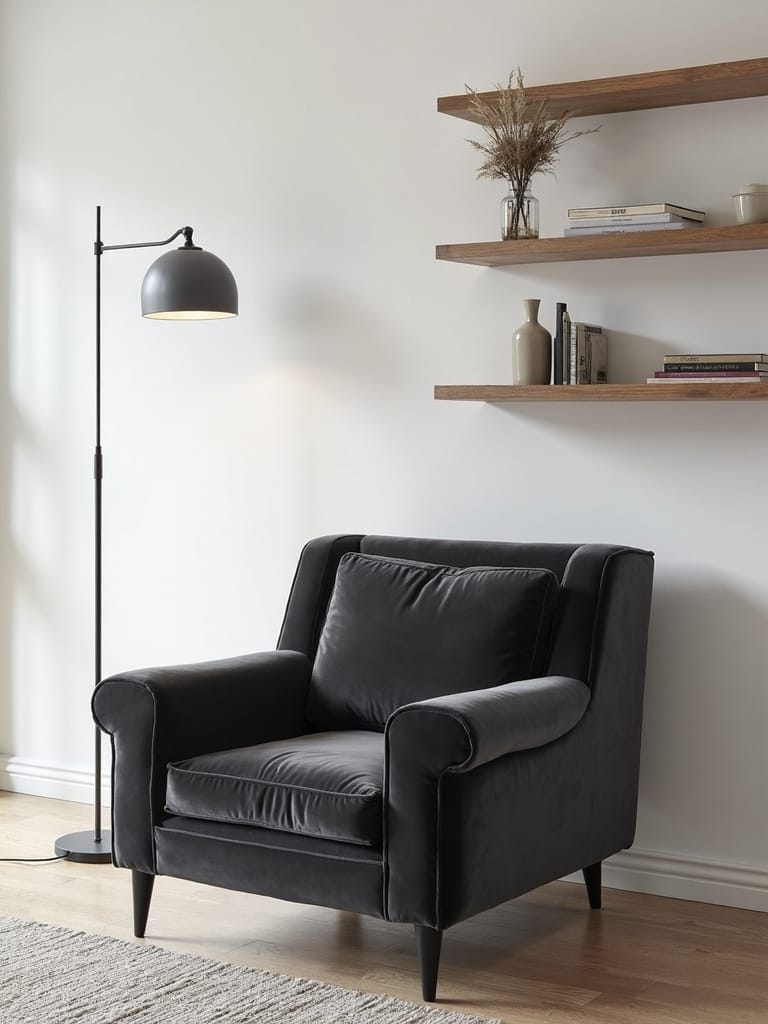
Statement pieces serve as the heartbeat of minimalist design, altering your living room from sparse to striking.
Choose a commanding focal point, like a sculptural sofa or distinctive coffee table, to anchor your space while maintaining a minimalist aesthetic.
Consider multifunctional items that blend style with practicality, such as a storage ottoman or an oversized art piece, keeping your room cohesive without sacrificing visual interest.
Maximize Natural Light Flow
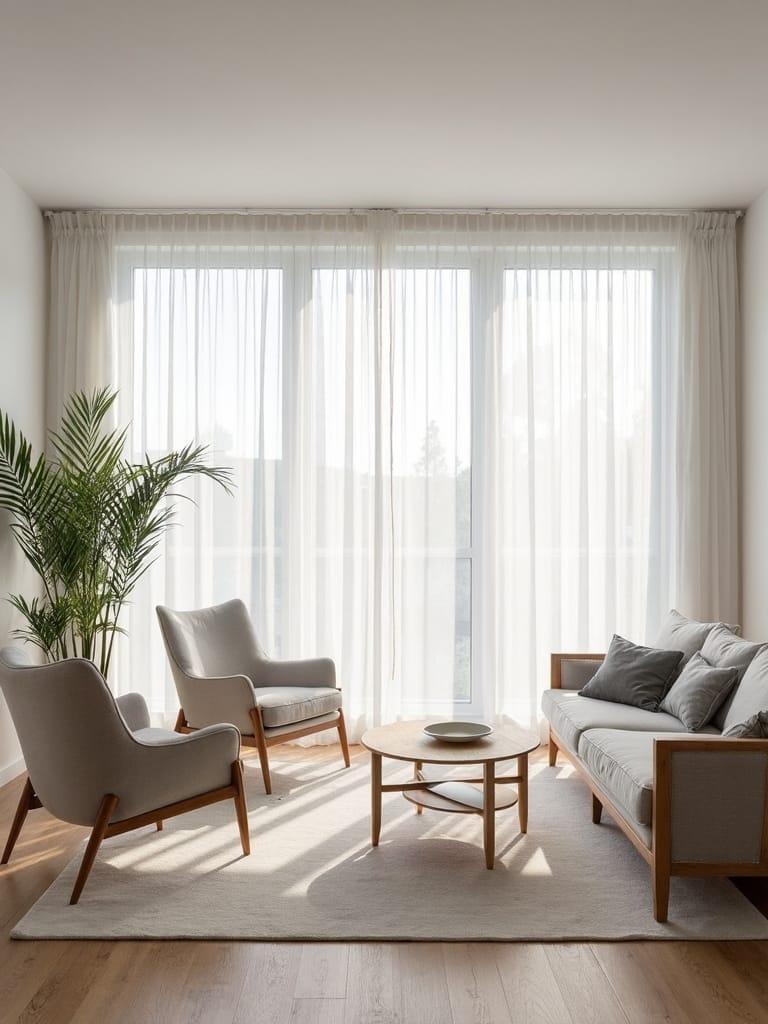
Natural light converts a minimalist living room into an expansive, welcoming sanctuary when you strategically arrange your space to maximize daylight flow.
Position your comfortable seating away from windows, and opt for white walls that reflect brightness throughout the room.
Incorporate natural materials and sheer curtains to create a soft, airy atmosphere while maintaining privacy.
Keep decor minimal to prevent blocking precious sunlight.
Layer Textures in Monochrome
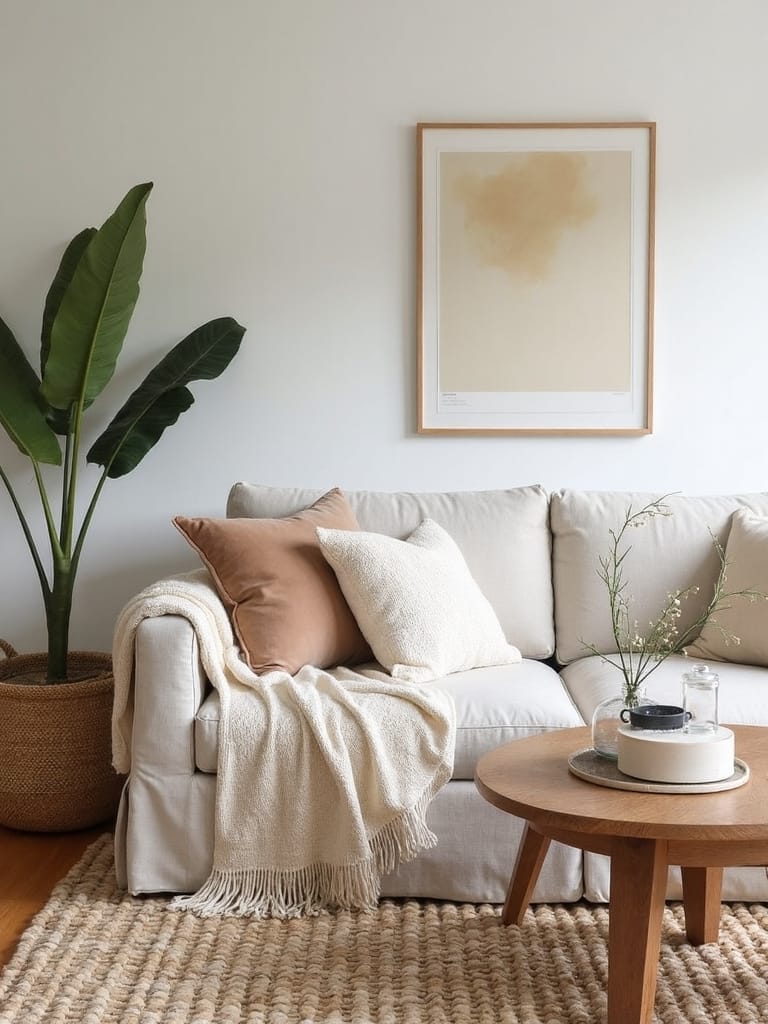
Sophisticated minimalism comes alive when you command the art of layering textures in a monochrome palette.
Create depth in your minimalist living room by mixing soft textiles with natural wood and sleek metals. You’ll find that combining matte and glossy finishes adds visual interest without disrupting serenity.
Choose accent pieces like woven throws and textured rugs in varying shades of your chosen neutral to maintain sophistication while avoiding visual clutter.
Design an Efficient Layout
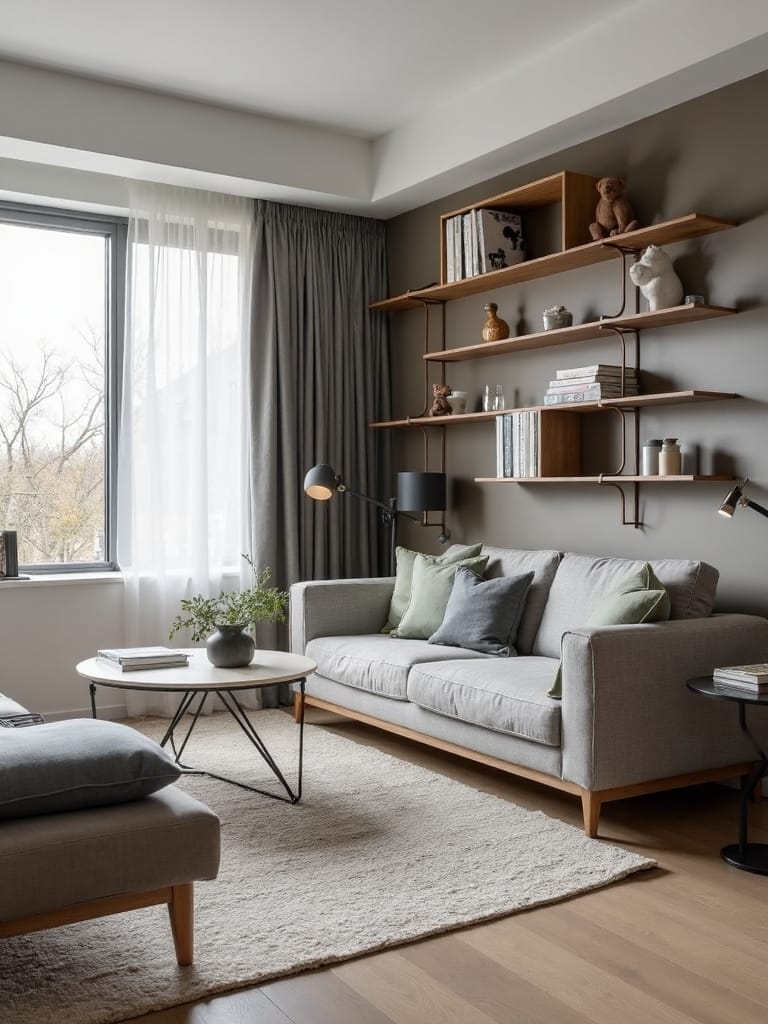
While maximizing space in a minimalist living room requires careful planning, you’ll find that an efficient layout converts even the smallest area into a functional haven.
Begin by creating distinct zones using multifunctional furniture to define your neutral space. Position low-profile seating against walls, incorporate storage ottomans as coffee tables, and establish a cohesive color palette throughout.
Add vertical shelving to maintain an open feel while maximizing storage potential.
Choose Minimalist Window Treatments
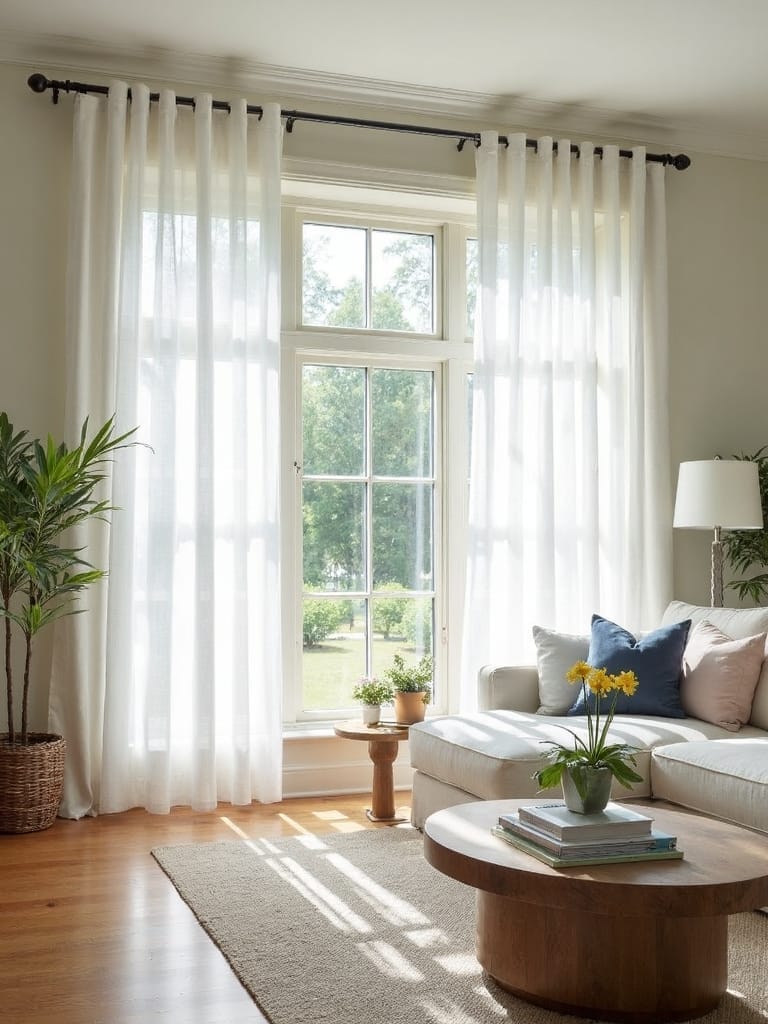
With your efficient layout in place, window treatments deserve special attention to maintain that minimalist appeal.
Select sheer curtains or light-filtering options that welcome natural light while preserving privacy.
For a clean minimalist interior, opt for simple roller shades in neutral tones, and consider floor-to-ceiling installations to create an illusion of height.
These choices will keep your space feeling open and uncluttered.
Add Subtle Pops of Color
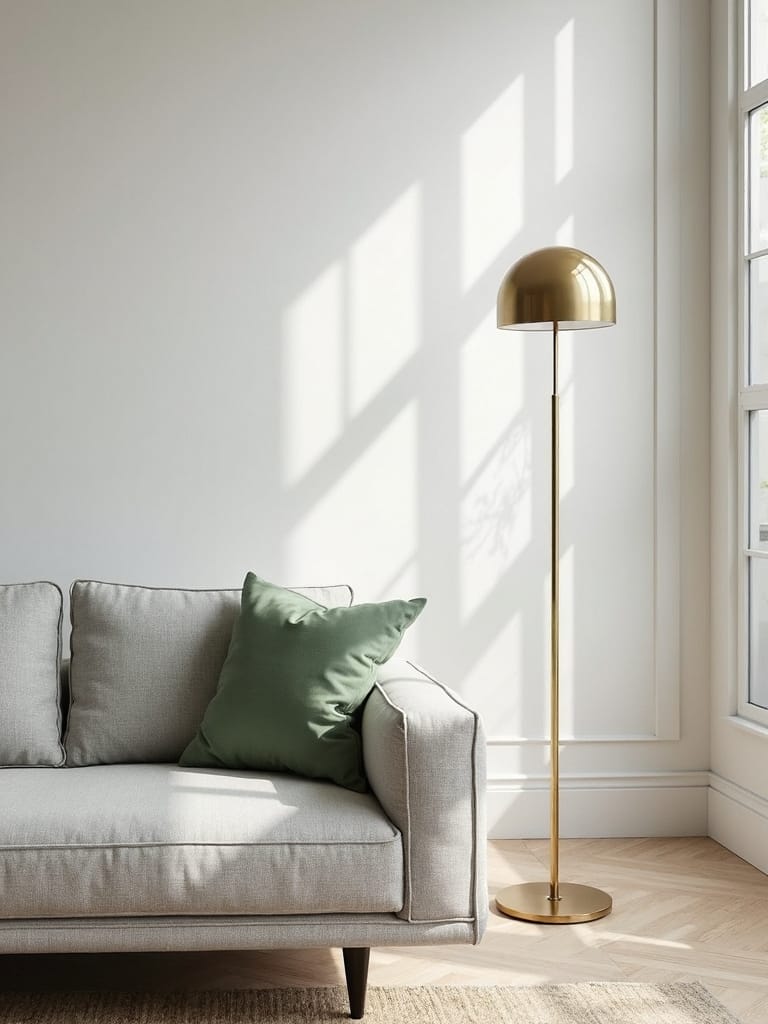
Adding subtle pops of color changes a minimalist living room from stark to inviting without compromising its clean aesthetic.
You’ll create visual interest by incorporating soft pastel throw pillows or a muted area rug.
Choose decorative objects like artwork and plants strategically, placing them where they’ll make the most impact.
Keep larger furniture pieces neutral to let your colorful accents shine within the minimalist aesthetic.
Optimize Vertical Storage Space
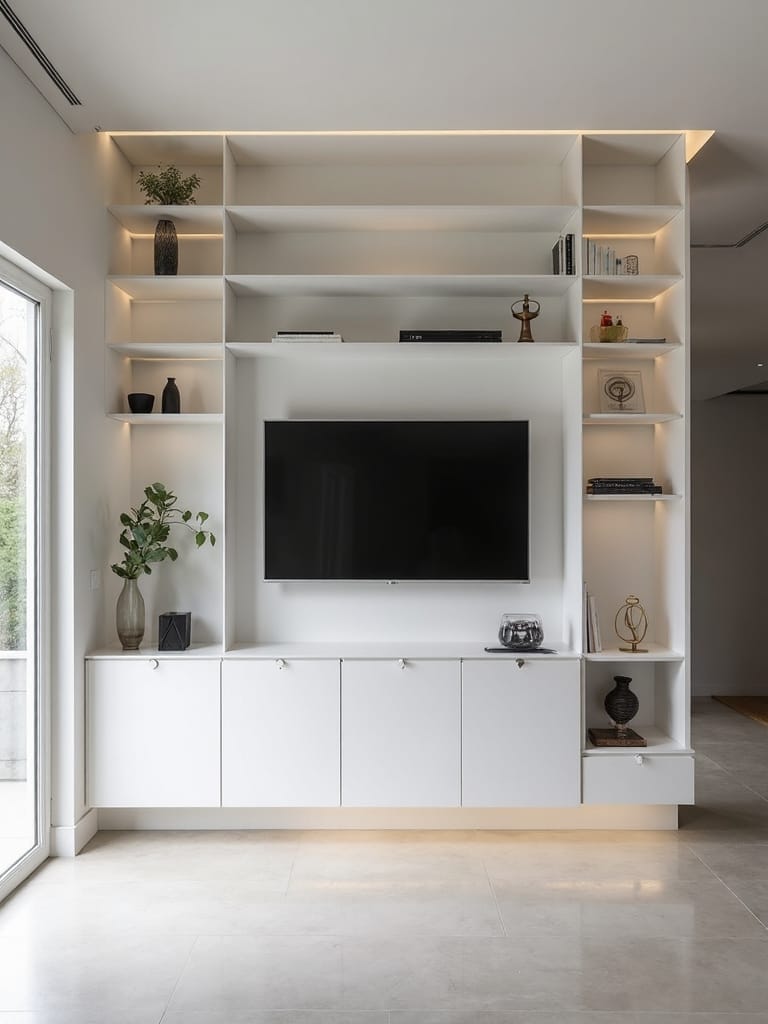
Making the most of vertical space revolutionizes your minimalist living room by creating storage opportunities where you least expect them.
Install wall-mounted shelves for books and decor, while utilizing tall, narrow cabinets against walls.
You’ll maintain a clutter-free environment by choosing multi-functional furniture with hidden storage, and incorporating vertical storage solutions like pegboards and hanging organizers for everyday items.
Focus on Quality Over Quantity
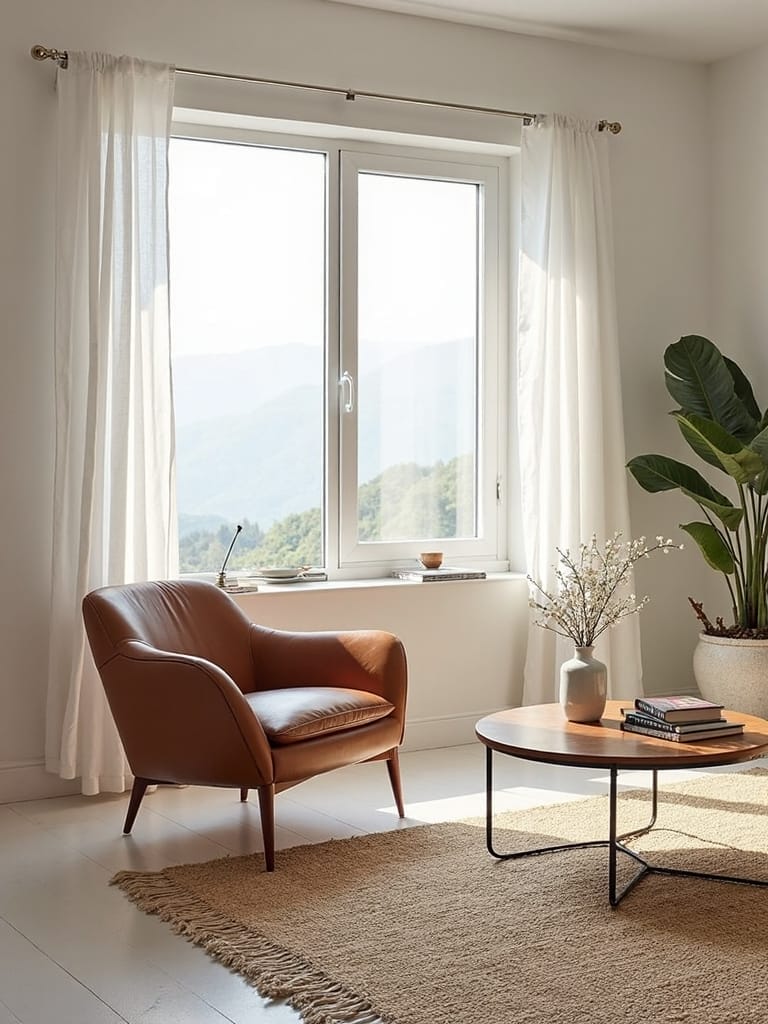
Quality furnishings form the backbone of a truly minimalist living room design.
When you’re selecting furniture pieces, prioritize timeless designs and premium materials that’ll stand the test of time.
You’ll benefit from investing in well-crafted items that serve multiple functions, ensuring both durability and functionality.
Integrate Hidden Storage Solutions
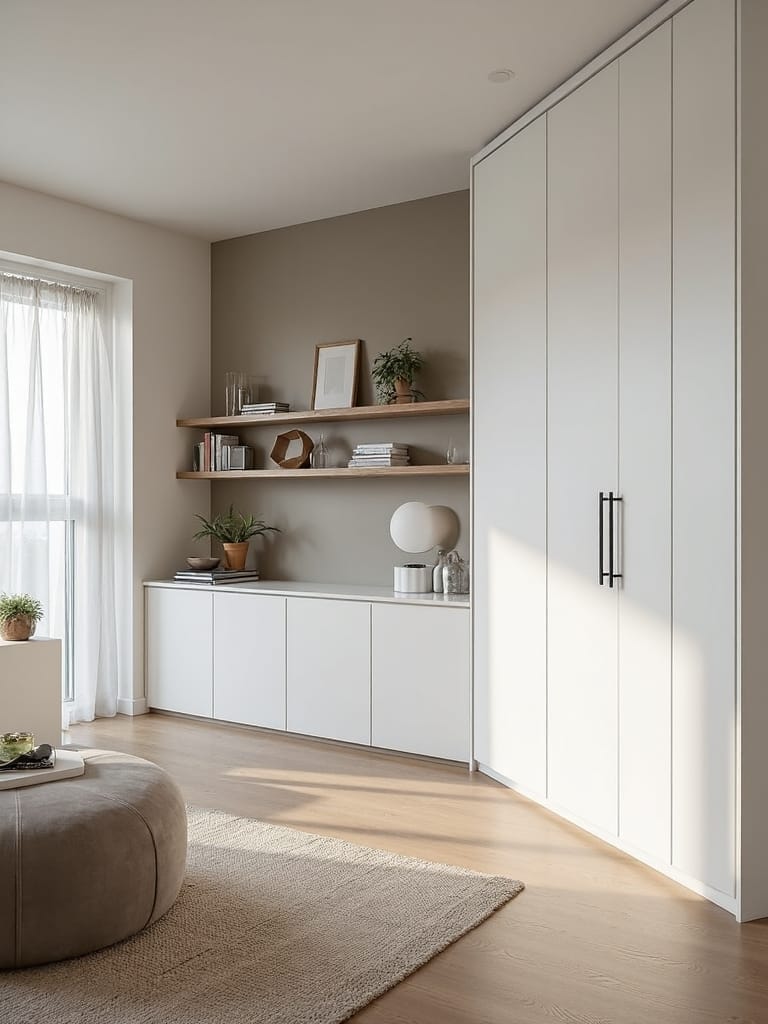
Smart storage solutions convert a minimalist living room from cluttered to serene.
You’ll maximize your space by incorporating hidden storage solutions like multifunctional furniture – think ottomans with compartments and coffee tables with drawers.
Mount shelves on walls to keep floor space open, and use decorative storage boxes that complement your minimalist aesthetic.
Built-in window seats with storage offer both style and function.
Establish a Cohesive Color Palette
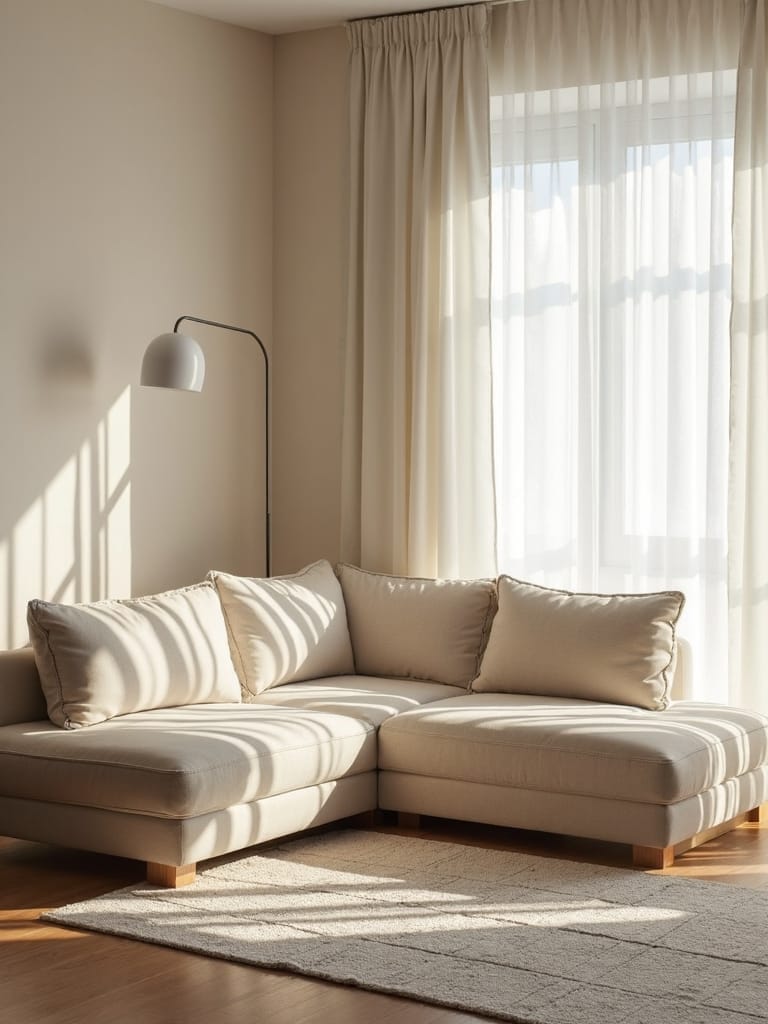
Once your storage solutions are in place, a thoughtful color palette becomes your next powerful tool for minimal living room design.
Create a cohesive color palette by selecting neutral colors and varying shades of white to establish tranquility.
You’ll find that muted tones or monochromatic schemes work beautifully to support your minimalist aesthetic while maintaining visual harmony in your small space.
Utilize Mirrors Strategically
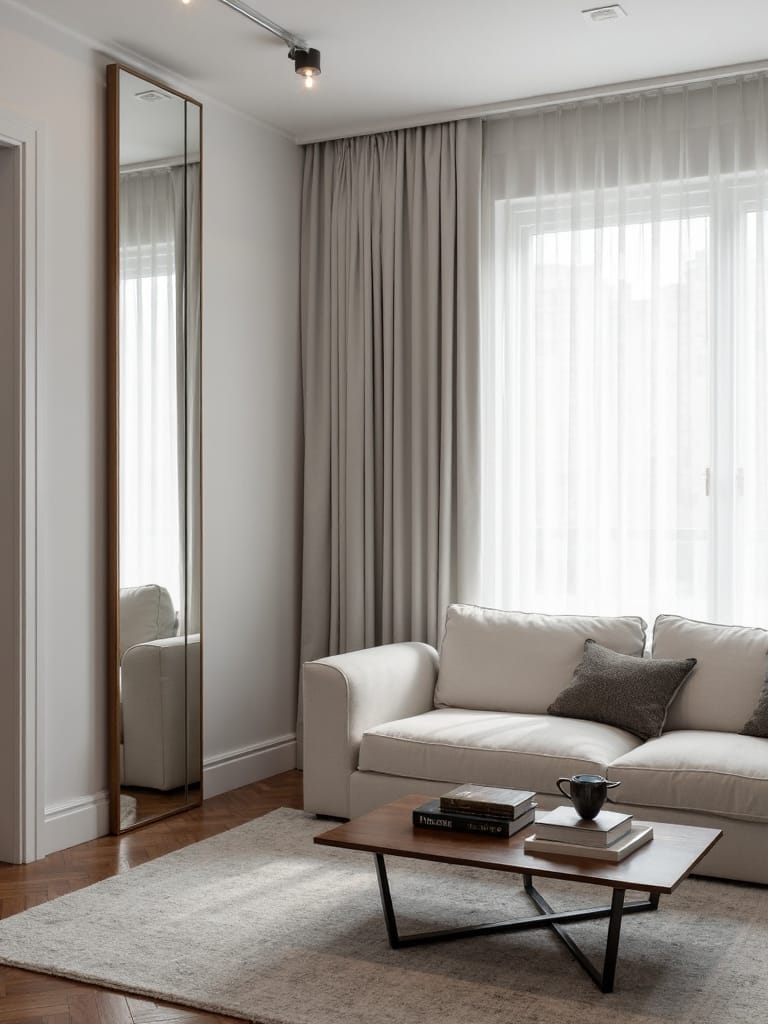
Strategic mirror placement serves as a powerful design tool in minimal living rooms, altering your space through the artful reflection of light and depth.
Position large mirrors opposite windows to maximize natural light and create an airy atmosphere in your small room.
For minimalist decor, choose a statement mirror with a distinctive frame as your focal point, enhancing symmetry while maintaining clean aesthetics.
Select Low-Profile Furniture
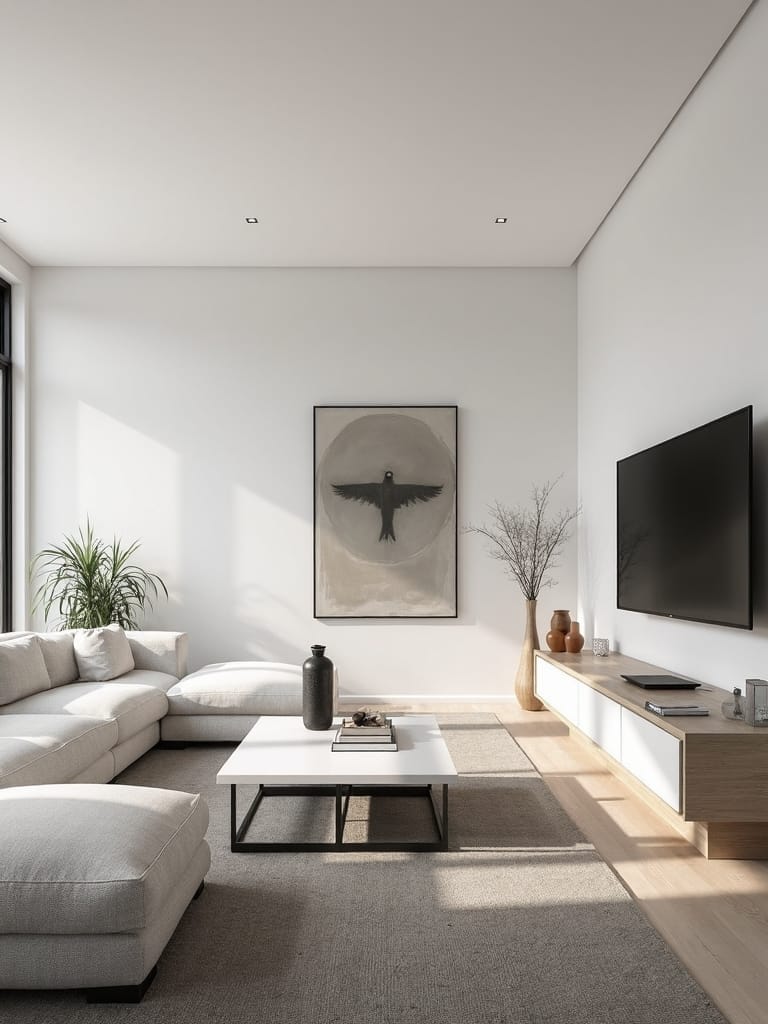
When designing a minimal living room, selecting low-profile furniture creates an open and airy atmosphere that alters your space.
Choose sleek pieces with clean lines to maintain a clutter-free look while maximizing natural light flow.
You’ll find that low-seated sofas and streamlined coffee tables not only enhance the room’s openness but also offer versatile arrangements that adapt effortlessly to your social gatherings and daily activities.
Create Breathing Room Between Elements

Proper spacing between furniture and decor elements alters a minimal living room from basic to breathtaking.
You’ll want to maintain 18-24 inches between seating pieces for ideal visual appeal and movement flow.
Pair your low-profile furniture with thoughtfully placed area rugs, leaving 6 inches of breathing room between decorative items.
This strategic spacing creates an organized, airy atmosphere that enhances your room’s overall aesthetic.
Define Zones Without Walls
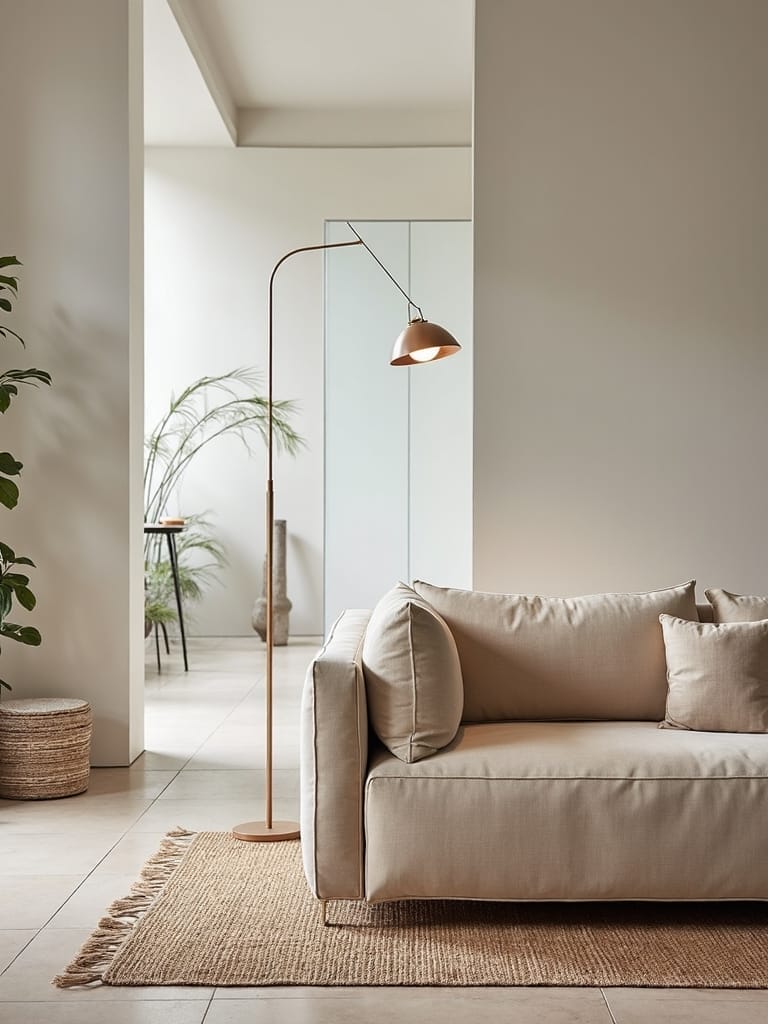
Clean lines and purposeful furniture placement create defined zones in your minimal living room without relying on physical walls.
Position multi-functional furniture like storage ottomans to establish distinct areas while maximizing space.
Layer rugs to visually separate seating from dining spaces, and install strategic lighting fixtures above each zone.
Natural elements and decorative screens offer subtle boundaries without disrupting flow.
Balance Negative Space
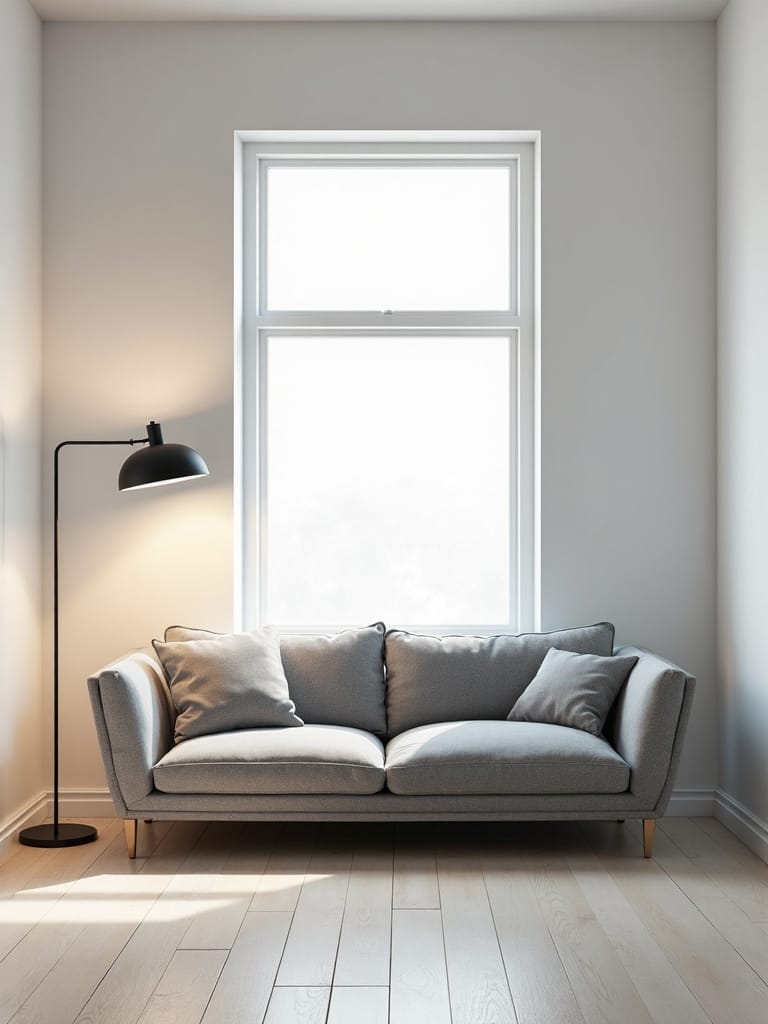
Strategic negative space serves as a powerful design element in minimal living spaces, creating visual harmony and mental tranquility.
To balance negative space in your small living room, position furniture with breathing room between pieces. You’ll achieve a clutter-free look by incorporating low-profile seating and regularly editing your decor items, allowing each element to stand out while maintaining an open, airy atmosphere.
Incorporate Natural Materials
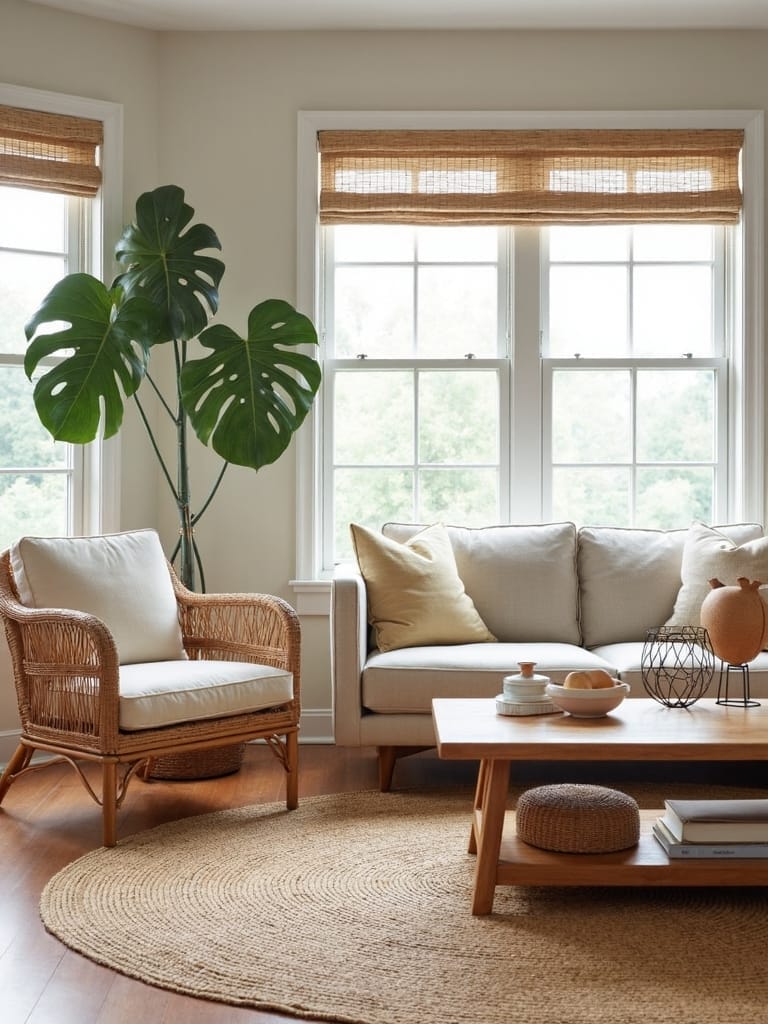
While negative space creates visual breathing room, natural materials bring life and depth to your minimalist living room.
Consider adding wood accents through reclaimed shelving or sleek furniture pieces that showcase unique grain patterns.
Incorporate natural elements like stone features for striking focal points, and choose quality leather seating that’ll provide lasting comfort while maintaining your minimalist design’s clean aesthetic.
Maintain Visual Flow Throughout
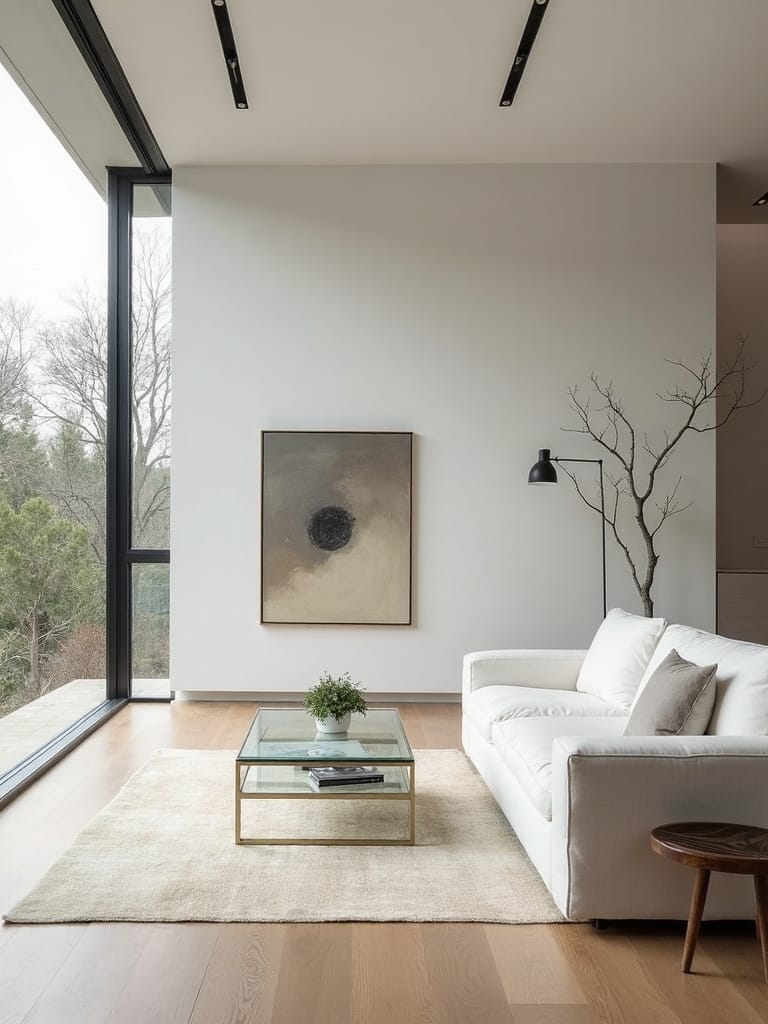
Establishing visual flow throughout your minimalist living room depends on a harmonious blend of thoughtful design elements working together.
Start with a cohesive color palette of whites, blacks, and neutrals. Then strategically place low-height and multipurpose furniture to maintain clear sightlines.
Position accent furniture to create distinct zones while keeping pathways open. Add large mirrors to enhance spaciousness and create an uninterrupted visual flow throughout your room.
Display Curated Artwork Thoughtfully

The art you choose and display can change your minimalist living room from a simple space into an enchanting sanctuary.
Select curated artwork that complements your minimalist aesthetic, focusing on pieces with a limited color palette that aligns with your room’s scheme.
Create a visual focal point by positioning art at eye level, and consider using a gallery wall format with consistent framing for multiple pieces.
Conclusion
You’ll find that changing your small living room into a minimalist haven isn’t as intimidating as it may seem. By incorporating these design principles – from floating furniture to curating meaningful decor – you’re well-equipped to create a graceful, clutter-free space that feels both sophisticated and welcoming. Remember, minimalism isn’t about emptiness; it’s about purposeful design choices that maximize both function and visual appeal in your compact living area.

